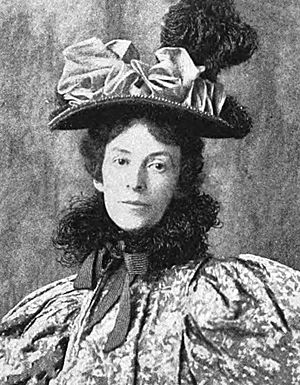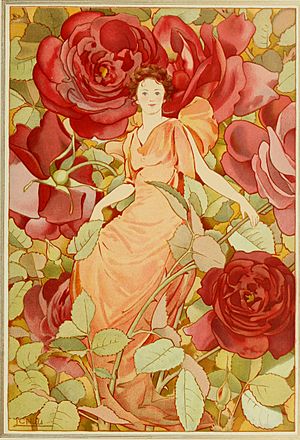Laura Coombs Hills facts for kids
Laura Coombs Hills (1859–1952) was an American artist. She was known for her beautiful paintings of flowers. She also painted tiny portraits on ivory. These small artworks are called miniatures. Laura was the first miniature painter chosen for the Society of American Artists. She also helped start the American Society of Miniature Painters. Besides painting, she designed things and drew pictures for children's books. She worked with authors like Kate Douglas Wiggin.
Contents
Early Life and Art Training
Laura Coombs Hills was born on September 7, 1859. She grew up in Newburyport, Massachusetts. She was one of five children. Her father was a banker, so her family was quite well-off.
Laura loved art from a young age. She had some art lessons in Boston. She studied with Helen M. Knowlton for three winters. She also spent two months at the Cowles Art School. In 1882, she went to New York City. There, she studied drawing for three months. One of her teachers was the famous artist William Merritt Chase.
In the early 1900s, Laura set up her art studio in Boston. But she spent her summers in Newburyport. She had a house there called the Goldfish. She shared it with one of her sisters. Between 1890 and 1929, she traveled to Europe five times. She wanted to learn more about art and culture there.
Her Art Career
Painting Flowers and Landscapes
In the 1880s, Laura painted landscapes using oil paints. These paintings showed the influence of other artists. Later, she preferred to use watercolors and pastels. These art materials were not always taken seriously back then. But Laura helped change that.
She had her first art show in 1889 in Boston. She showed pastel landscapes and still life paintings. A still life is a painting of objects, like flowers or fruit. She kept showing her watercolors and pastels throughout her career. As her eyesight got worse later in life, she focused more on pastels.
Laura was famous for her bright, colorful flower paintings. She often painted flowers from her own garden. One art critic called her the "Queen of Flower Painters." The Boston Museum of Fine Arts bought one of her pastel paintings in 1926. It was called Larkspur, Peonies, and Canterbury Bells. This painting became very popular.
Miniature Portraits
In the 1890s, Laura visited England. There, she became very interested in miniature paintings. These are tiny portraits painted on ivory. She taught herself this detailed art style. By 1893, she had painted a series of miniature portraits. They were of girls from her hometown. This series was called Seven Pretty Girls of Newburyport. These paintings helped start her long career as a miniature artist. They are now in the Boston Museum of Fine Arts.
Laura was considered one of America's best miniature painters. She was also an innovator in this art form. She used bold brushstrokes and bright colors. This was different from the traditional way of painting miniatures.
In 1896, she received a special request. Emily Dickinson's sister, Lavinia, asked Laura to fix a photo of the poet. Emily Dickinson had passed away. The original photo was taken when Emily was young. Neither Emily nor her sister liked it much. Laura used the photo to create a memorial portrait. She made Emily's hair softer and curlier. She also added a fancy dress. Lavinia was very pleased with the result. This portrait appeared in several books about Emily Dickinson.
In 1897, Laura made history. She became the first miniature painter chosen for the Society of American Artists. She was one of only a few women in this group. A year later, she helped create the American Society of Miniature Painters. She even served as its vice-president. After 1920, she painted fewer miniatures. This was because her eyesight was getting worse.
Design and Illustrations
Laura also earned money by creating commercial artwork. She painted watercolors for greeting cards and calendars. She drew patterns for needlework. She also decorated pottery. Her 1897 calendar, Dream Roses, was very popular. It showed young women surrounded by many flowers. The style was inspired by Art Nouveau.
She also drew pictures for children's magazines. One was called St. Nicholas. She illustrated children's books too. These included an 1889 edition of Kate Douglas Wiggin's The Birds' Christmas Carol. She also illustrated Anna M. Pratt's Flower Folk. She continued this work even when her paintings and miniatures were selling very well.
Awards and Later Life
Laura Coombs Hills showed her paintings and miniatures in many places. She won several awards. These included medals at big international shows. Some of these were the 1900 Paris Exposition and the 1904 St. Louis Exposition.
Laura continued to work as an artist almost until she passed away. She died on February 21, 1952. Her papers are kept in important art archives. These include the Smithsonian Institution and the Historical Society of Old Newbury.
See also
 In Spanish: Laura Coombs Hills para niños
In Spanish: Laura Coombs Hills para niños




